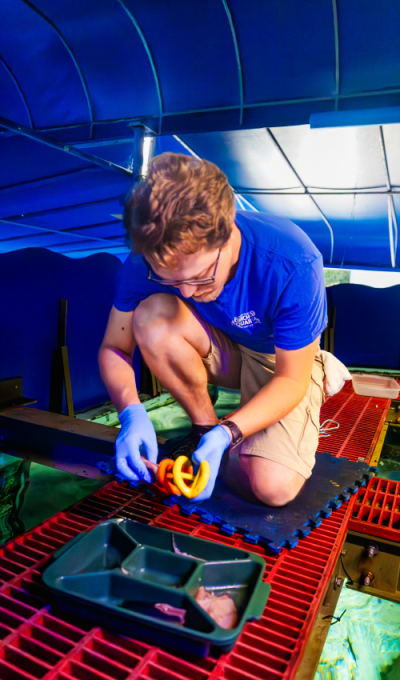All animals require expert care, from providing exactly the right food they need, to ensuring they receive excellent medical care to encouraging mental and physical stimulation through enrichment. Enrichment is anything that alters the day-to-day routine in a way that mimics something the animal encounters in the wild so they can use a wide range of their natural behaviors. At Birch Aquarium at Scripps Institution of Oceanography, we enrich our animals including sharks and rays to enhance their care and overall health.
“Sharks and rays are especially intelligent, curious, and food-motivated animals,” said Brent Fish, Aquarist. “Enrichment is a vital way we can enhance their well-being and help them thrive in their environments.”
Birch Aquarium uses a variety of enrichment techniques for the resident sharks and rays in order to create experiences similar to their natural habitats. Environmental enrichment could include changing the lighting in their habitat to mimic different weather conditions or adding or removing rocks and other obstacles to their environment so they change their navigation. Adding things like kelp to the habitat simulates other kinds of seasonal change, such as Giant Kelp’s growing season here in southern California.

Foraging Behaviors Encouraged
Other activities for sharks and rays might include added foraging opportunities. Everyday items like puzzle balls stocked with small pieces of food are similar to objects like shells or rocks on the seafloor, which sharks and rays manipulate to find small prey. Our rays in particular are expert foragers, and will claim a spot to suction out their favorite foods. Food puzzles can also be suspended higher in the water for the animals to retrieve. This variation provides a challenge for the sharks and rays to use their senses to find where exactly in the water column the food is, much like they would in their wild habitats.

“We try to create experiences that encourage the animals to engage in their natural behaviors,” said Fish. “For sharks and rays, this might include relying on their strong sense of smell to locate food, using their snouts or mouths to access challenging food sources, competing with other animals in their ecosystem, changing swimming patterns in response to a dynamic environment, pattern learning, and lots more. Even if the items we use don't exactly mimic things the animals would find in their natural habitat, they still create unique and stimulating challenges for the animals to solve."
Even simply changing the type of food they receive can create a new experience for them, mimicking the variety that they encounter through hunting. At Birch Aquarium, sharks and rays receive a rotation of unique food options in addition to their regular diet including yellowtail, shrimp, mullet, anchovies, herring and salmon, which are all restaurant-grade and evaluated based on sustainability. The sharks have preferences as well, just like people do, and this varies by individual animal with some preferring certain food over others.
Our sharks and rays are not the only animals at Birch Aquarium we provide with enrichment. We aim to provide enriching experiences across all animal groups including species like our Giant Pacific Octopus, Little Blue Penguins and Loggerhead Sea Turtle who each receive various kinds of enrichment specially designed for their specific needs.
To learn more about shark and ray conservation, and how to get involved in protecting these amazing creatures, visit AZA SAFE: Sharks and Rays.